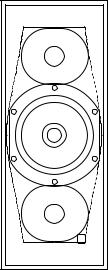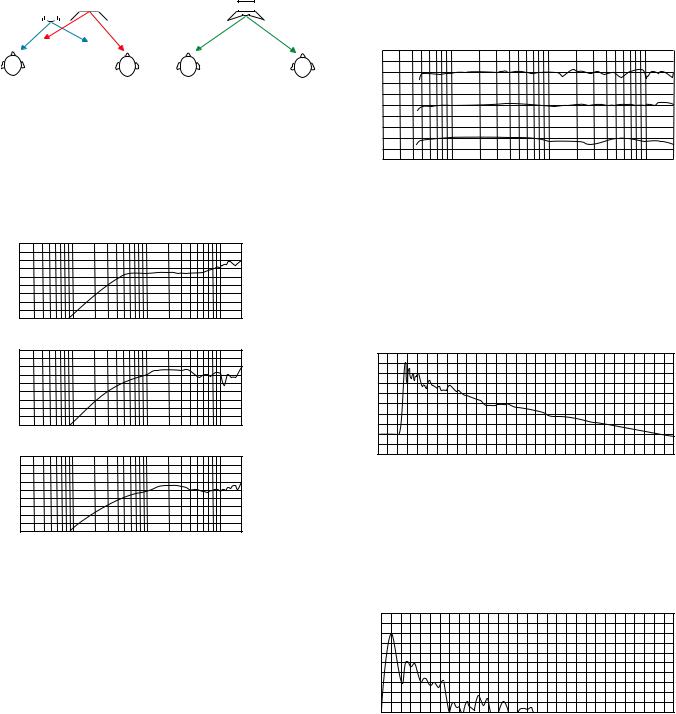Thiel SCS-3 Brochure

Supplemental Technical Information for model
THIEL SCS3
Coherent Source® Loudspeaker
This paper contains only information specific to the SCS3 speaker system. It is intended to supplement the general technical information paper which explains our engineering philosophy, goals and techniques.
THIEL SCS3 SPECIFICATIONS
Bandwidth (-3 dB) |
46 Hz - 22 kHz |
Amplitude response |
48 Hz - 20 KHz ±2 dB |
Phase response |
minimum ±10° |
Sensitivity |
87 dB @ 2.8 v-1m |
Impedance |
4Ω, 3Ω minimum |
Recommended Power |
30-200 watts |
Size (W x D x H) |
7.5 x 10 x 19 inches |
Weight |
30 lb |
Driver Complement: Woofer
6.5" (5.1" radiating area) with anodized aluminum cone, cast frame, 1.7" dia voice coil. Underhung coil (short coil/ long gap) motor system. Linear travel 3/16" pk-pk, 3 in3 linear displacement. 2.5 lb. magnet, 6 lb total magnet structure plus 1.2 lb. shielding magnet. Copper pole sleeve. Made by THIEL.
Tweeter
1" (1.2" radiating area) with anodized aluminum dome. Aluminum coil. Underhung coil (short coil/long gap) motor system. Linear travel 1/8" pk-pk. Powered by 5 neodymium magnets weighing 1.7 oz. Copper pole sleeve.
Ferrofluid. Coincident with midrange.
7/00

Time coherent topology
An important design goal for the SCS3 which is not shared with our floor-standing products is placement flexibility. The requirement that the speaker provide time coherence while placed either vertically or horizontally and at any height necessitates that the speaker be symmetrical both horizontally and vertically and, therefore, that it use either coincident or D’Appolito driver configuration. The SCS3 uses coincident/ coaxial mounting of a very high output 1" tweeter and a high output 61/2" woofer.
Typical Shelf Speaker |
|
THIEL SCS3 |
||||||||||||
|
|
Placed on Side |
|
|||||||||||
|
|
|
|
|
|
|
|
|||||||
|
|
|
|
|
|
|
|
|
|
|
|
|
|
|
|
|
|
|
|
|
|
|
|
|
|
|
|
|
|
|
|
|
|
|
|
|
|
|
|
|
|
|
|
|
|
|
|
|
|
|
|
|
|
|
|
|
|
|
|
Off-axis Listeners
(top view) |
Off-axis Listeners |
|
|
Two-way speaker positioned on its side |
Coincident driver mounting results in all |
causes the sound from the drivers to reach |
listeners hearing the sound from the |
the off-axis listener at different times. |
drivers at the same time. |
Coaxial tweeter response
To maintain time coherence the tweeter must be aligned with the woofer. There is usually a significant problem with the response of tweeters which are mounted coaxially in a woofer. Energy from the tweeter is reflected from the woofer’s diaphragm and causes destructive interference.
|
|
|
|
|
This |
|
25 |
|
|
|
graph shows |
dB |
20 |
|
|
|
the response |
15 |
|
|
|
||
— |
10 |
|
|
|
of the |
Amplitude |
|
|
|
||
5 |
|
|
|
||
|
|
|
SCS3’s |
||
0 |
|
|
|
||
-5 |
|
|
|
tweeter in an |
|
|
|
|
|
||
|
-10 |
|
|
|
|
|
20 |
100 |
1K |
10K |
20K infinite |
|
|
|
Frequency |
|
baffle and |
|
|
|
|
|
|
|
25 |
|
|
|
the second |
|
|
|
|
shows the |
|
dB |
20 |
|
|
|
|
15 |
|
|
|
tweeter’s |
|
— |
10 |
|
|
|
|
Amplitude |
|
|
|
||
|
|
|
response |
||
5 |
|
|
|
||
0 |
|
|
|
||
|
|
|
when |
||
-5 |
|
|
|
||
|
|
|
|
||
|
-10 |
|
|
|
coaxially |
|
|
|
|
10K |
|
|
20 |
100 |
1K |
20K |
|
|
|
|
Frequency |
|
mounted in |
|
|
|
|
|
|
|
|
|
|
|
a typical |
|
25 |
|
|
|
woofer. |
|
20 |
|
|
|
|
dB |
|
|
|
Irregularities |
|
15 |
|
|
|
||
— |
10 |
|
|
|
can be seen |
Amplitude |
|
|
|
||
5 |
|
|
|
||
0 |
|
|
|
above 4KHz |
|
-5 |
|
|
|
||
|
|
|
|
caused by |
|
|
-10 |
|
|
|
|
|
20 |
100 |
1K |
10K |
20K |
Frequency
diffraction
effects. The SCS3’s woofer diaphragm shape has been designed to
greatly reduce negative effects on the tweeter’s response as can be seen in the third graph. By shaping the diaphragm as a short tube opening into a shallow flare reflections are almost entirely eliminated. In addition, the woofer’s surround is mounted to the rear of the diaphragm such that the tweeter does not really “see” it as a diffraction-causing obstruction. Since the shape of the woofer’s diaphragm has been optimized for the tweeter’s response rather than to minimize its own resonances, it would not exhibit response as good as it otherwise would. To remedy this problem the woofer diaphragm is reinforced with very light and stiff molded polystyrene on its back side.
Frequency response
The graphs below show the frequency response of the SCS3. The upper graph shows the (normal) on-axis response and illustrates the very high degree of accuracy; no frequency is under or over emphasized more than 2 dB.
The second graph shows the on-axis, octave-averaged response. This curve is representative of the speaker’s tonal balance and shows that the SCS3 is very accurately balanced, any over or under emphasis below 12 KHz is less than 0.5 dB.
The third graph shows the 30° off-axis, octave averaged response and illustrates that the speaker’s overall energy response is well balanced, with no large depressions in any area of the spectrum. This high degree of uniformity is in part the result of the SCS3’s first order crossover system.
On-axis, octave averaged, 30°octave averaged
|
10 |
|
dB |
5 |
|
0 |
||
— |
||
-5 |
||
Amplitude |
||
-10 |
||
|
-15 -20 -25 -30
20 |
100 |
1K |
10K |
20K |
Frequency
Step response
This graph shows the SCS3’s response to a step signal. Notice that the overall triangular shape is very well preserved with the output remaining smoothly positive until 2.6 ms when it finally crosses zero due to the fact that the bass response extends to 46 Hz rather than DC. The irregularities seen in the first few hundred microseconds are due to the tweeter diaphragm resonance at the ultrasonic frequency of about 23 KHz. Waveform accuracy this good can only be achieved with first order crossovers and time coherent driver positioning.
Output
0.5 |
1.0 |
1.5 |
2.0 |
2.5 |
Time – msec
Time response
The energy-time response of the SCS3 shows that the speaker’s output quickly decays to -40 dB in 1.5 milliseconds, indicating very clean inter-transient silence. Such performance is the result of metal diaphragms that have no resonances within their operating frequency range and very strong cabinet construction.
|
5 |
|
|
|
|
|
0 |
|
|
|
|
dB |
-5 |
|
|
|
|
-10 |
|
|
|
|
|
— |
-15 |
|
|
|
|
Output |
|
|
|
|
|
-20 |
|
|
|
|
|
|
|
|
|
|
|
|
-25 |
|
|
|
|
|
-30 |
|
|
|
|
|
-35 |
|
|
|
|
|
0.5 |
1.0 |
1.5 |
2.0 |
2.5 |
|
|
|
Time – msec |
|
|
